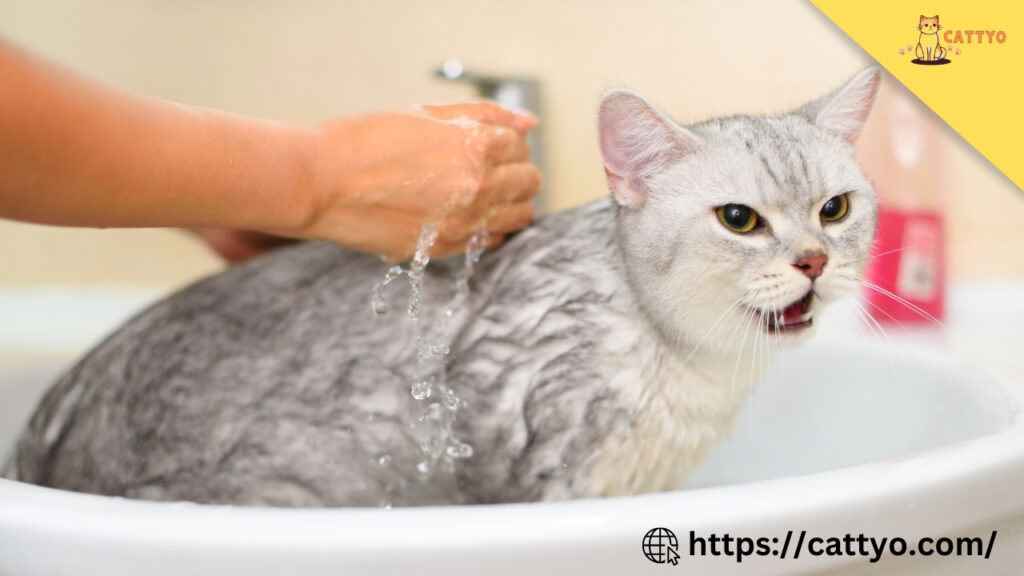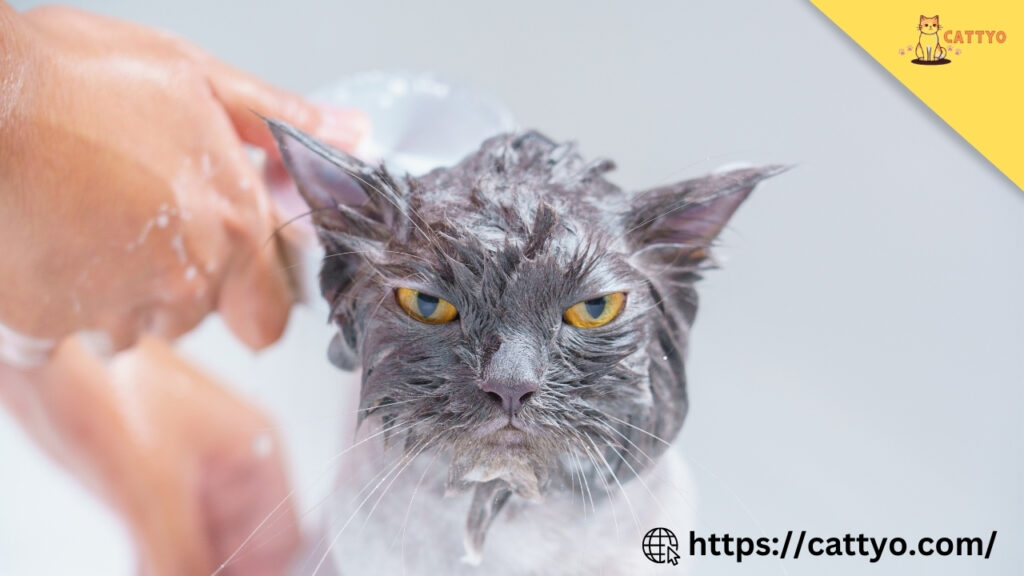If you’ve ever tried bathing a cat, you probably walked away wet, scratched, and wondering if there’s a better method. Good news—there is. The best way to clean a cat doesn’t have to be a full-blown water fight. With the right steps, you can clean your feline friend gently and safely, without anyone getting hurt.
Let’s explore when cats need cleaning, how to do it without stress, and what tools work best. By the end, you’ll feel confident handling even the grumpiest furball.
The Best Way to Clean a Cat: Step-by-Step
Now let’s walk through how to clean your cat without creating a disaster. This includes traditional baths and water-free alternatives.

Step 1: Brush Before You Bathe
Brushing removes loose fur, dirt, and knots. It also calms your cat and reduces hair clumps during the bath.
Choose the right brush:
| Brush Type | Best For |
|---|---|
| Slicker brush | Long-haired cats |
| Rubber grooming mitt | Short-haired cats |
| De-shedding tool | Heavy shedders |
Step 2: Gather Your Supplies
Make sure you have everything ready before you start. This makes the process smoother and faster.
What You’ll Need:
- Cat-specific shampoo (no human products)
- A cup or handheld sprayer
- Two dry towels
- A non-slip mat for the sink or tub
- A calm, enclosed space (like a bathroom)
Step 3: Use Warm (Not Hot) Water
Cats are sensitive to temperature. Fill your tub or sink with about 2-3 inches of lukewarm water. Keep your cat calm by talking softly.
Gently wet your cat using a cup or sprayer—avoid the face. Apply shampoo and lather lightly from the neck down. Rinse thoroughly to remove all residue.
Step 4: Dry Gently and Quickly
Use a towel to blot (not rub) your cat’s fur. You can wrap them like a burrito to keep them warm. If they tolerate it, use a hairdryer on the lowest setting—but most cats prefer towel drying.
Pro Tip: Keep your bathroom warm and draft-free during and after the bath.
Do Cats Really Need to Be Bathed?
Cats are naturally clean animals. They groom themselves by licking their fur, which helps remove dirt, spread oils, and stay tidy. But sometimes, their grooming isn’t enough.
When a Bath Is Actually Necessary:
- Your cat got into something sticky, oily, or toxic.
- They’re older, sick, or overweight and can’t groom themselves properly.
- Fleas or skin issues require medicated baths.
- You’re dealing with allergies and need to control dander.
If your cat is healthy and active, chances are you don’t need to bathe them often—maybe once or twice a year at most.
Waterless Alternatives: A Cat Parent’s Best Friend
Not all cats need water baths. In fact, the best way to clean a cat might be a water-free method—especially if your cat hates water.
Dry Shampoo or Foam Cleaners
These are rubbed into your cat’s fur and wiped off with a cloth. They’re great for quick clean-ups.
Cat Grooming Wipes
Perfect for removing dirt, allergens, or oil spots. Choose unscented, hypoallergenic wipes.
Spot Cleaning with a Damp Cloth
For small messes, just use a damp cloth and gently wipe the affected area. Always dry the fur afterward.
Tips to Make Cleaning Your Cat Easier
Let’s be honest—cleaning a cat isn’t always a walk in the park. But these tips can save you a lot of stress (and bandaids):
Before the Bath:
- Trim your cat’s nails a day or two before.
- Tire them out with playtime beforehand.
- Keep the room warm and calm.
During the Bath:
- Stay calm—your cat will feed off your energy.
- Talk to them in a soft voice.
- Have treats nearby for positive reinforcement.
After the Bath:
- Wrap them in a towel and cuddle (if they’ll let you).
- Offer treats or playtime.
- Let them retreat to their favorite quiet space.
Grooming Essentials for Cat Owners
Here’s a simple breakdown of the grooming tools every cat owner should have:
| Tool | Purpose |
|---|---|
| Cat shampoo | For safe, skin-friendly cleaning |
| Brushes/combs | Removes loose fur and mats |
| Nail clippers | Keeps claws manageable |
| Wipes | Quick spot-cleaning |
| Microfiber towel | Fast drying |
Signs Your Cat Might Need Cleaning Help
Sometimes cats need more than self-grooming.
Watch for These Signs:
- Strong or unusual odors
- Matted or greasy fur
- Dirt or litter stuck in fur
- Fleas or skin irritation
- Difficulty grooming due to age or obesity
If your cat shows these signs, it may be time to intervene—or visit a vet or groomer.
Natural Cleaning Options for Sensitive Cats
If your cat has allergies or sensitive skin, avoid harsh chemicals.
Look for These Natural Ingredients:
- Oatmeal
- Aloe vera
- Chamomile
- Coconut-based cleaners
Avoid products with alcohol, parabens, or artificial fragrances. Natural options are gentler and reduce skin irritation risks.
Professional Grooming: When to Call in the Experts
If your cat has thick mats, chronic skin issues, or simply hates being bathed, consider a professional groomer.

Benefits of Professional Grooming:
- Safe, stress-free environment
- Medicated treatments for skin conditions
- Nail trimming and ear cleaning included
- Ideal for long-haired or elderly cats
You can ask your vet for recommendations or find local groomers with cat-handling experience.
Related Topics Worth Exploring
Here are some related articles you might enjoy:
- How Often Should You Bathe Your Cat?
- Best Brushes for Long-Haired Cats
- What to Do if Your Cat Hates Water
- Natural Remedies for Cat Dandruff
FAQ: Cleaning Your Cat
How often should I clean my cat?
Usually, once every few months or when they get dirty. Healthy cats groom themselves daily.
Can I use baby wipes to clean my cat?
No. Baby wipes can contain chemicals that irritate your cat’s skin. Use pet-safe grooming wipes.
What if my cat hates water?
Try waterless shampoos, wipes, or spot cleaning. If needed, seek help from a professional groomer.
Do indoor cats need to be cleaned?
Yes, though not often. Dust, hair, and litter can build up in their coat, especially in older or long-haired cats.
What shampoo is safe for cats?
Use only cat-specific shampoos with natural ingredients. Never use dog or human shampoo.
Final Thoughts: Keeping It Simple
The best way to clean a cat is the one that works for you and your feline friend. Whether it’s a full bath or just a quick wipe-down, being gentle, patient, and prepared makes all the difference.
Cats may not love the process, but with practice and care, they’ll tolerate it—and stay healthy and happy. Start slow, reward good behavior, and remember: it doesn’t have to be perfect.


